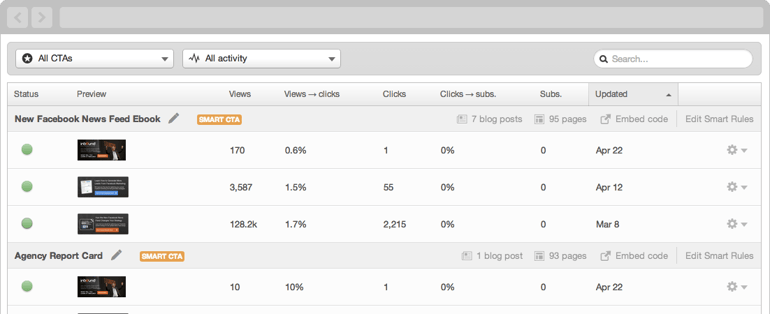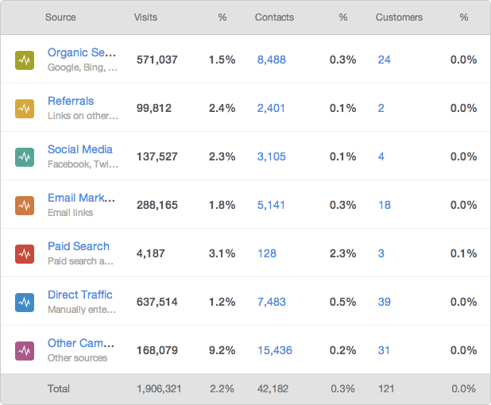Lead generation; the process of attracting and converting strangers and prospects into leads.
But you knew that already, didn’t you?
Lead generation, especially b2b lead generation, is one of the most important aspects of your business. If you’re not generating leads, you’re not generating potential inquiries – and if you’re not generating those, you’ll have no potential profit to look forward to.
Simple, right?
Wrong.
According to last year’s State of Inbound Marketing report, of the 4,500+ non-HubSpot respondents reviewed, 65% of them said their main challenge was generating leads.
This represents a huge problem.
If you’re having trouble converting website visitors into leads, there’s something wrong with the conversion stage of your marketing process.
In the wider Inbound Marketing methodology, you should be looking to attract strangers to your website through high-quality content or organic search. Once you have visitors on your website, you need to ensure that your website is correctly set-up to convert visitors into contacts. This can be done in a variety of ways, from eBook downloads, to blog subscription forms, webinars and pricing or product documents.
If you’re running an Inbound Marketing campaign, your content marketing strategy at the attract phase should revolve around filling the top of your content funnel with educational content. Essentially, top of the funnel content is awareness stage material that provides your visitors with valuable information about the problems they are facing, as well as problems they may not know they have. In addition, your website and blog should incorporate a CTA (call-to-action) which lead visitors towards landing pages and forms, which drive the conversion process.
So why is all of this important?
Well, with the marketing tools available today, it’s easy for the marketer to identify the source of their visitors, whether they engaged with some of your website content and clicked through to a landing page, or if they arrived there via organic search. While the latter will be likely to score you more qualified leads (as they’ve conducted a precise keyword search for a particular problem they’re experiencing and arrived on your site) the former, in terms of converting those leads, is heavily reliant on the quality of the content on the landing page.
It’s crucial that you understand the correlation between your attraction phase content and the content you designate on your landing page. As previously mentioned, the analytics tools available today mean that everything that passes through your website is readily trackable - meaning you can easily identify the source of your visitors. If people have read for example, an awareness piece blog on ‘top marketing apps’, then clicked a CTA embedded in the piece and landed on a page offering an eBook which provides an advanced analysis of each marketing app - you’ve aligned your content offering. Not only this, but you’ve most likely delighted your visitor, and you can also identify where that visitor came from in the first place.
On the other hand, the same scenario, but the landing page content you’re offering is an eBook completely unrelated to the content which brought them there in the first place, there’s a disconnect.
In essence then, throughout the attraction to conversion process, from stranger, to visitor, to lead - with the technology available today, you can identify at each stage the content which brought that enquiry to your website.
And that’s where HubSpot comes in.
HubSpot tracks this all for you
If you have a comprehensive, dedicated marketing platform such as HubSpot, you can ascertain where each visitor came from and what content they interacted with on your site. This provides you with not only tremendous visibility, but also an understanding of what is and isn’t working.
For example, the CTAs you create in HubSpot are designed to collect a variety of information, providing a number of metrics which enable you to see the traversal from stranger, to visitor to lead. To clearly convey what that looks like, we’ve included a little image snippet below.

As you can see, you can quickly ascertain what is and isn’t working. If the CTAs you’re embedding in your awareness stage content are receiving clicks, but you’re failing to convert visitors arriving on the landing page, you can quickly see what the problem is.
Find your sources
HubSpot also has a nifty function called ‘Sources’ on the dashboard tab, under ‘Reports’, which effectively accumulates information on where all your visitors arrived from. You’ve got:
-
Organic search: Search queries conducted via search engines
-
Referrals: Links from other websites to your site
-
Social media: Facebook, Twitter, Instagram, LinkedIn etc.
-
Email marketing: anyone who you’ve contacted through your email outreach
-
Direct traffic: people who have directly arrived at your website by typing in your URL, or alternatively, have received your URL through a third-party messaging application such as WhatsApp.
-
Paid Search: Paid search advertisements
Here’s what it looks like:

In addition, HubSpot breaks down each individual traffic segment to highlight where you’re acquiring your contacts from, allowing you to see what channel is producing the most conversions from visitor to contact. It’s imperative however, that you allocate a marketing campaign to every item in HubSpot so that you can align all of your marketing channels around a single objective or goal. You can associate your campaigns with landing pages, calls-to-action, emails, blog posts, social messages, keywords, pay-per-click visits, traffic from other sources, and workflows. The purpose of having campaigns allocated to your marketing material means that you can easily interpret and analyse the data in front of you to determine what’s working, making measuring your ROI simple. We’ll talk about running effective campaigns in a later blog.
Now you have all of this information at your fingertips, you can clearly determine a path of action. If your blog posts are drawing visitors, but you’re not converting them, you know that the landing page you’re directing them to needs to be re-evaluated. It might mean that the content on your landing page doesn’t reflect the quality of the offer, the visuals aren’t enticing enough, the form doesn’t reflect the value of the offer or what you’re offering is completely unrelated to what brought your visitor there.
When it comes to your business’ lead generation goals, having a clear understanding of just where you are failing to convert visitors will enable you to refine your marketing campaign to ensure you can capture those visitors. Without the information to guide your efforts, you are effectively marketing blind and making assumptions!









.png)





